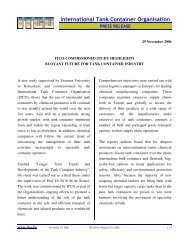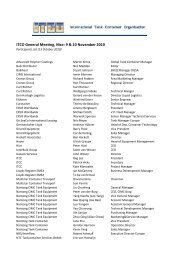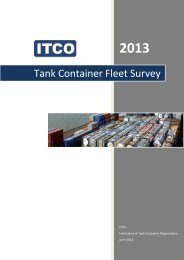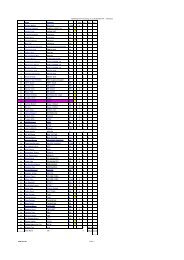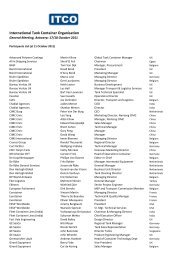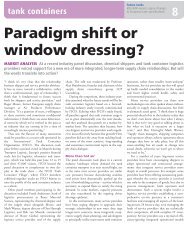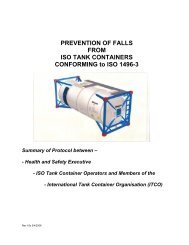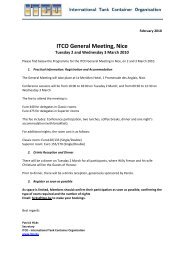You also want an ePaper? Increase the reach of your titles
YUMPU automatically turns print PDFs into web optimized ePapers that Google loves.
ICHCA International <strong>Safe</strong>ty Panel Briefing Pamphlet No 30<br />
12.2.5 The different designs for the tank supporting frames determine the stacking<br />
capability <strong>of</strong> the tank container. Most ISO tank containers are built to the<br />
provisions <strong>of</strong> ISO 1496 part 3 which will require that the container is built to<br />
withstand a superimposed load <strong>of</strong> 192,000 kg. This value is the equivalent<br />
<strong>of</strong> eight superimposed containers with an average mass <strong>of</strong> 24,000kg.<br />
12.2.6 Table 1 shows the stacking configuration for a selection <strong>of</strong> average<br />
superimposed container masses. Note the mass <strong>of</strong> the bottom container is<br />
not taken into account when calculating the superimposed average mass.<br />
Average gross<br />
mass (kg) <strong>of</strong><br />
containers<br />
24,000 30,480 32,500 34,000 36,000<br />
Stack height 8 over 1 6 over 1 5 over 1 5 over 1 5 over 1<br />
Laden<br />
container stack<br />
12.2.7 There are few international tank containers in service today with a maximum<br />
gross weight rating <strong>of</strong> 30,480 kg so, as shown in Table 1, the maximum<br />
configuration will generally be five fully laden tank containers stacked over<br />
the bottom one (total six per stack).<br />
12.2.8 However swap tanks have a different design and therefore a different<br />
stacking capability. The wider designed width <strong>of</strong> these units means that<br />
there is a step between the corner posts and the top corner fittings. Pictures<br />
59 and 60 show examples <strong>of</strong> the step in the post.<br />
Picture 59 Picture 60<br />
Table 1<br />
12.2.9 <strong>Containers</strong> with a step <strong>of</strong> this nature will generally have a lower stacking<br />
capability. The container may be marked with a warning decal that indicates<br />
that there is a reduced stacking capability.<br />
12.2.10 The safety approval plate example shown in Picture 58 is such a tank<br />
container where the maximum gross value <strong>of</strong> 36,000 kg and a reduced<br />
allowable stacking weight <strong>of</strong> 72,000 kg. This means that only two similar<br />
and fully laden containers can be stacked above it. .<br />
12.2.11 When considering a stack <strong>of</strong> tank containers, the maximum superimposed<br />
load <strong>of</strong> the bottom container will dictate the total stack height. A container<br />
with the stacking capability <strong>of</strong> the units shown in Picture 58 can only have<br />
two containers placed above it, whether they are the stronger international<br />
or the weaker European loading unit. On the other hand a tank container<br />
Page 38 ©ICHCA International Limited



